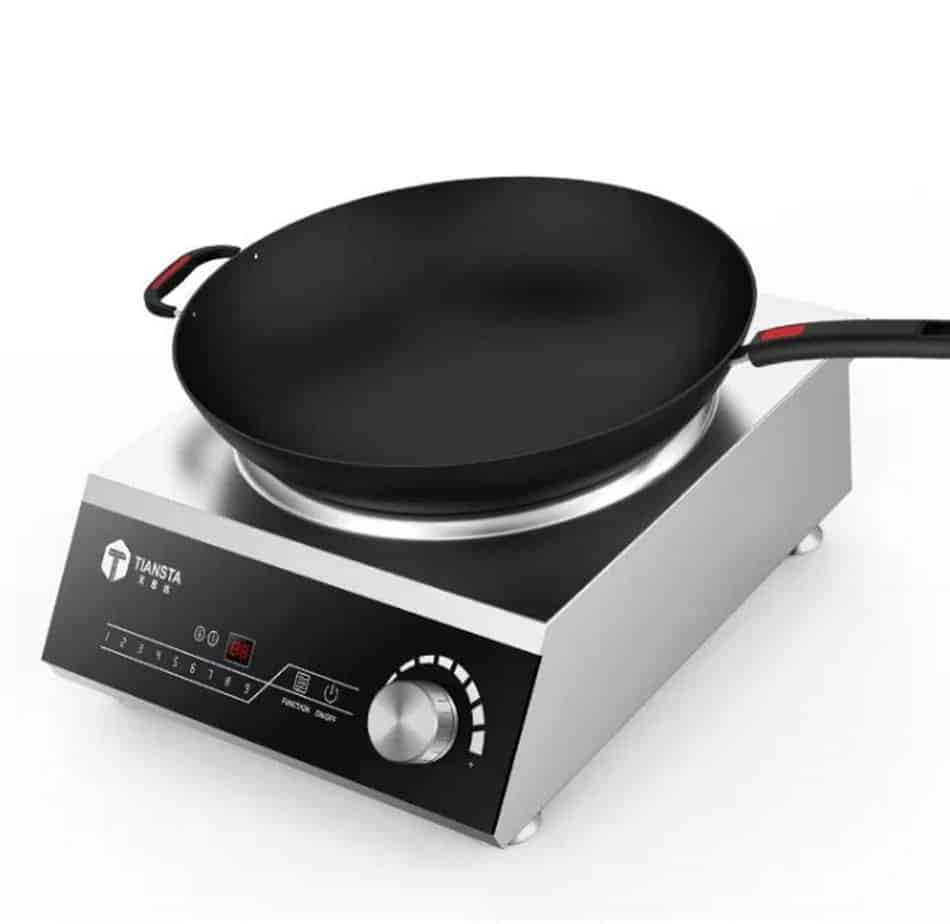Woks are excellent cookware for just about anything, from stirfry, popcorn, mussels, eggs, and much more. The problem with a wok is that it requires high heat. And the heat source is usually an open flame.
This type of cooking is not suited to all types of property. For example, some condo units prohibit the use of an open flame. Luckily, there’s a new kid on the block: induction burners for woks.
You may have heard of induction burners but are unfamiliar with them.
Induction uses electric currents and heats the wok through magnetic induction. Heat is activated when the wok is placed onto the induction wok burner. Unlike gas or electric heat sources that transfer thermal heat to the cookware, induction heats the wok and works almost instantly.
What is induction wok?
There are two types of induction woks: commercial use and home use.
Induction technology has advanced over the years. For the most part, this type of appliance used to be too bulky for home use. In addition, these burners would use up a lot of energy, make a lot of noise, and are very expensive for the average home cook.
But today, an entire market caters to induction woks for home use. For those unfamiliar with induction, let me explain.
An induction wok burner uses electrical currents that heat the wok through magnetic induction. These currents heat the wok itself and not the area around the wok. The heat is generated inside the metal. This type of heating results in the wok heating up almost instantly. Food is cooked much faster and with more consistency. For a wok to work on an induction burner, the wok must be made of a specific type of ferrous material such as stainless steel, cast iron, or carbon steel.
In addition, there is no cool-down period. With traditional gas and electric work burners, the cooking appliances and the cookware will need a cooling period after cooking. However, with induction cookware, there is no cool-down period. After lifting the wok off the induction burner, the electric currents stop transmitting magnetic energy, breaking the circuit, and the wok and burner are cool to the touch.
The best induction burner for home use
An ideal wok burner will be small, portable, and produce sufficient heat to create wokhei. It will be made with high-quality, durable material and can control time and heat in increments.
The bottom of the wok is the first and essential factor in understanding an induction wok versus a traditional wok. A traditional wok may have either a flat or rounded bottom. An induction wok will have a flat bottom. The reason is that the bottom of the wok needs to make sufficient contact with the surface of the induction stove. However, there are induction burners that fit woks with a rounded bottom.
Next, you may want to consider the size of the wok. Do you have a big family, and will you be using the wok to cook for them, or do you require a small one? In addition, will the wok fit on your induction cooktop, and does your current induction cooktop support induction wok cooking? Do you currently have an induction stovetop, or will you be investing in an induction burner?
And, lastly, how much money are you prepared to invest in an induction burner for a wok?
You may want to consider perusing the best induction wok burner review to find a wok that is ideal for you.
The pros of using an induction burner
Consumes less energy
Traditional electrical stoves and gas stoves both consume high amounts of energy and, in turn, run up your electric or gas bill. An induction burner uses much less energy and can run off the main electrical power supply. Using an induction burner will save quite a lot in the long run.
Safety
Induction cookware and burners do not heat up like traditional cookware and stoves. There are no open flames, as in the case of gas cooking, and no hot elements that may cause you to burn. There is no residual heat when the induction cookware is removed from the burner. Therefore, this cookware and burners are much safer and reduce the risk of burning.
Cooler kitchen
Heat is only created when induction cookware makes contact with induction surfaces. There is no need to keep the stovetop on to keep consistent heat or prevent heat loss during cooking. This means you will not have to open windows and doors to allow fresh air to enter and release warm air.
Easier to clean
Induction burners generally have smooth surfaces. This makes it very easy to clean your burner after use, making your life easier.
The cons of using an induction burner
No wokhei
The biggest drawback of induction burners is that many will not be able to achieve wokhei as you do with a traditional wok. This can only be achieved by tossing your food in a wok over an open flame. The oil particles ignite during this process, which helps to achieve wokhei. This is necessary when cooking traditional Chinese dishes and gives the dish its distinctive flavor.
Indoor use versus outdoor use
Induction burners may be used indoors and outdoors, provided there is an electrical outlet for the burner outside. Induction burners come in various sizes; some are small and delicate, and others are bulky and heavy. You may find a portable burner, but you will still require an electrical outlet.
If you plan to go camping and want to take your induction burner with you, a wide range of burners are equipped for outside use. That is what makes these burners so versatile.
Induction burner versus traditional gas burner
The most significant difference between these two burners is that induction burners are much safer and consume much less energy than gas wok burners. On the other hand, you will only be able to achieve wokhei on a traditional gas wok burner. You will not be able to flip the wok on an induction burner as you do on a gas wok burner, and you won’t be able to ignite the oil particles.
Another critical difference between these two heat sources is that integrated stove gas wok burners are inefficient.
If your wok burner is a part of your gas stove, then the situation is a bit different than with the powerful outdoor wok burner. You may find that some parts of your wok, when using stove integrated wok burner heat up faster than other parts, which may cause your food to burn. Induction burners heat the wok evenly and consistently from all sides, ensuring that your food cooks evenly from start to finish.
The second most significant difference between these two heat sources is that induction burners consistently produce high-quality cooking results.

